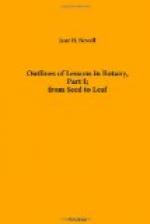Let each of the scholars take one of the sections of Oak and write a description of its markings. The age is easily determined; the pith rays, or medullary rays, are also plain. These form what is called the silver grain of the wood. The ducts, also, are clear in the Oak and Chestnut. There is a difference in color between the outer and inner wood, the older wood becomes darker and is called the heart-wood, the outer is the sap-wood. In Birds-eye Maple, and some other woods, the abortive buds are seen. They are buried in the wood, and make the disturbance which produces the ornamental grain. In sections of Pine or Spruce, no ducts can be found. The wood consists entirely of elongated, thickened cells or fibres. In some of the trees the pith rays cannot be seen with the naked eye.
Let the pupils compare the branches which they have described, with a stalk of Asparagus, Rattan, or Lily. A cross section of one of these shows dots among the soft tissue. These are ends of the fibro-vascular bundles, which in these plants are scattered through the cellular tissue instead of being brought together in a cylinder outside of the pith. In a vertical section they appear as lines. There are no annular rings.
If possible, let the pupils compare the leaves belonging to these different types of stems. The parallel-veined leaves of monocotyledons have stems without distinction of wood, bark and pith; the netted-veined leaves of dicotyledons have exogenous stems.
Dicotyledons have bark, wood, and pith, and grow by producing a new ring of wood outside the old. They also increase by the growth of the woody bundles of the leaves, which mingle with those of the stem.[1] Twist off the leaf-stalk of any leaf, and trace the bundles into the stem.
[Footnote 1: See note, p. 127, Physiological Botany.]
Monocotyledons have no layer which has the power of producing new wood, and their growth takes place entirely from the intercalation of new bundles, which originate at the bases of the leaves. The lower part of a stem of a Palm, for instance, does not increase in size after it has lost its crown of leaves. This is carried up gradually. The upper part of the stem is a cone, having fronds, and below this cone the stem does not increase in diameter. The word endogenous, inside-growing, is not, therefore, a correct one to describe the growth of most monocotyledons, for the growth takes place where the leaves originate, near the exterior of the stem.
Gray’s First Lessons. Sect. VI. Sect, XVI, sec. 1, 401-13. sec. 3. sec. 6, 465-74.
How Plants Grow. Chap. 1, 82, 90-118.
VI.
LEAVES.
We have studied leaves as cotyledons, bud-scales, etc., but when we speak of leaves, we do not think of these adapted forms, but of the green foliage of the plant.




